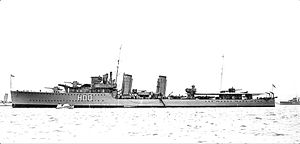HMCS Restigouche (H00)

Restigouche in original configuration with four 4.7-inch guns, tall second funnel and AA gun between the funnels
|
|
| History | |
|---|---|
|
|
|
| Name: | Comet |
| Ordered: | 15 July 1930 |
| Builder: | Portsmouth Dockyard |
| Laid down: | 12 September 1930 |
| Launched: | 30 September 1931 |
| Completed: | 2 June 1932 |
| Identification: | Pennant number: H00 |
| Motto: | Follow the Light |
| Fate: | Transferred to the Royal Canadian Navy and renamed Restigouche, 11 June 1938 |
| Badge: | On a Field Black, a Comet Silver |
|
|
|
| Name: | Restigouche |
| Namesake: | Restigouche River |
| Commissioned: | 11 June 1938 |
| Decommissioned: | 6 October 1945 |
| Identification: | Pennant number: H00 |
| Honours and awards: |
Atlantic 1939–45, North Sea 1940, Mediterranean 1943, Normandy 1944, Biscay 1944 |
| Fate: | Scrapped, 1946 |
| General characteristics as built | |
| Class and type: | C-class destroyer |
| Displacement: |
|
| Length: | 329 ft (100.3 m) o/a |
| Beam: | 33 ft (10.1 m) |
| Draught: | 12 ft 6 in (3.8 m) |
| Installed power: | 36,000 shp (27,000 kW) |
| Propulsion: |
|
| Speed: | 36 knots (67 km/h; 41 mph) |
| Range: | 5,500 nmi (10,200 km; 6,300 mi) at 15 knots (28 km/h; 17 mph) |
| Complement: | 145 |
| Armament: |
|
HMS Comet was a C-class destroyer built for the Royal Navy in the early 1930s. She saw service in the Home and Mediterranean Fleets and the ship spent six months during the Spanish Civil War in late 1936 in Spanish waters, enforcing the arms blockade imposed by Britain and France on both sides of the conflict. Comet transferred to the Royal Canadian Navy (RCN) in 1938 and renamed HMCS Restigouche. During World War II, she served as a convoy escort in the battle of the Atlantic, on anti-submarine patrols during the invasion of Normandy, and was employed as a troop transport after VE Day for returning Canadian servicemen, before being decommissioned in late 1945. Restigouche was sold for scrap in 1946.
Comet displaced 1,375 long tons (1,397 t) at standard load and 1,865 long tons (1,895 t) at deep load. The ship had an overall length of 329 feet (100.3 m), a beam of 33 feet (10.1 m) and a draught of 12 feet 6 inches (3.8 m). She was powered by Parsons geared steam turbines, driving two shafts, which developed a total of 36,000 shaft horsepower (27,000 kW) and gave a maximum speed of 36 knots (67 km/h; 41 mph). Steam for the turbines was provided by three Admiralty 3-drum water-tube boilers. Comet carried a maximum of 473 long tons (481 t) of fuel oil that gave her a range of 5,500 nautical miles (10,200 km; 6,300 mi) at 15 knots (28 km/h; 17 mph). The ship's complement was 145 officers and men.
...
Wikipedia
